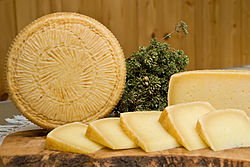Pecorino
This article needs additional citations for verification. (June 2025) |
| Pecorino | |
|---|---|
 | |
| Country of origin | Italy |
| Source of milk | Sheep |
| Texture | Hard |
Pecorino is an Italian hard cheese produced from sheep's milk. The name pecorino derives from pecora, which means 'sheep' in Italian.[1]
Overview
[edit]This section needs additional citations for verification. (June 2025) |

Of the six main varieties of pecorino, all of which have protected designation of origin (PDO) status under European Union law, pecorino romano is probably the best known outside Italy, especially in the United States, which has been an important export market for the cheese since the 19th century.[2] Most pecorino romano is produced on the island of Sardinia, although its production zone also includes Lazio and the Tuscan provinces of Grosseto and Siena. Ancient Roman authors wrote about this cheese and its production technique.[3]
The other five mature PDO cheeses are the pecorino sardo from Sardinia (casu berbeghinu in Sardinian language); pecorino toscano, whose production was already attested by Pliny the Elder in his Natural History;[4][better source needed] pecorino siciliano (or picurinu sicilianu in Sicilian); pecorino di Filiano from Basilicata;[5] and pecorino crotonese from the province of Crotone, in Calabria.[6] Another well-known pecorino is the one that was produced in Abruzzo, the pecorino di Atri.[7][8]
All come in a variety of styles depending on how long they have been aged. The more matured cheeses, referred to as stagionato (lit. 'seasoned' or 'aged'), are harder but still crumbly in texture and have decidedly buttery and nutty flavours. The other two types, semi-stagionato and fresco, have a softer texture and milder cream and milk tastes.[citation needed]
Tradition
[edit]This section needs additional citations for verification. (June 2025) |

A variant from southern Italy is pecorino pepato (lit. 'peppered pecorino'), to which black peppercorns are added. Today many other additions are made, for example walnuts, rocket, or tiny pieces of white or black truffle.[citation needed]
In Sardinia, the larvae of the cheese fly are intentionally introduced into pecorino sardo to produce casu martzu. As it is illegal, it is primarily sold through the black market.[9]
See also
[edit]![]() Media related to Pecorino at Wikimedia Commons
Media related to Pecorino at Wikimedia Commons
- List of Italian cheeses
- List of Italian DOP cheeses – food with protected designation of origin status
- Pecorino di Carmasciano
- Pecorino di Filiano
- Pecorino romano
- Pecorino sardo
- Pecorino siciliano
- Pecorino toscano
References
[edit]- ^ pecorino, n. OED Online. December 2013. Oxford University Press. Accessed 7 January 2014.
- ^ Export statistics Archived 2007-09-28 at the Wayback Machine from the producers’ consortium
- ^ Italian Pecorino and Ancient Roman
- ^ Pecorino Toscano Consortium for the Protection of Tuscan Pecorino (in Italian)
- ^ "Guide to PDO and PGI products: Pecorino of Filiano". www.10q.it. Archived from the original on January 3, 2015.
- ^ "Pecorino Crotonese DOP cheese". www.guffantiformaggi.com. Archived from the original on 2017-05-11. Retrieved 2016-02-26.
- ^ Barberis, Corrado (2010). Mangitalia: la storia d'Italia servita in tavola (in Italian). Donzelli Editore. p. 194. ISBN 978-88-6036-449-4.
- ^ Cremona, Luigi; Soletti, Francesco (2002). L'Italia dei formaggi (in Italian). Touring Editore. p. 97. ISBN 978-88-365-2727-4.
- ^ Agostino Petroni (18 March 2021). "Casu marzu: The world's 'most dangerous' cheese". CNN.
